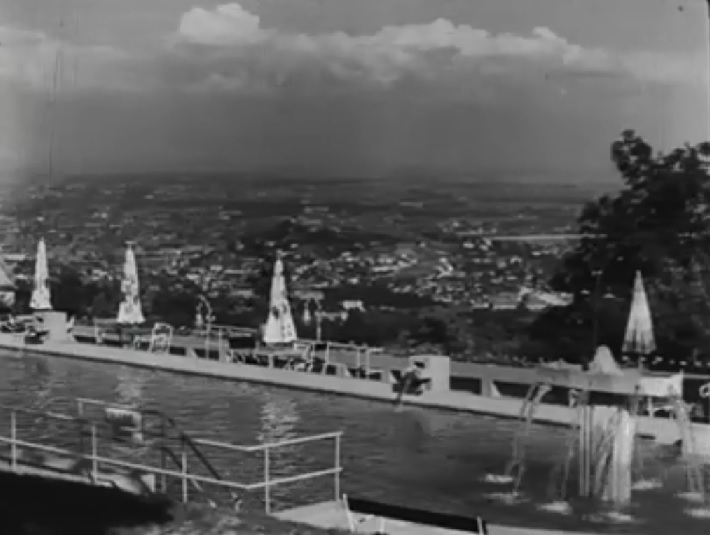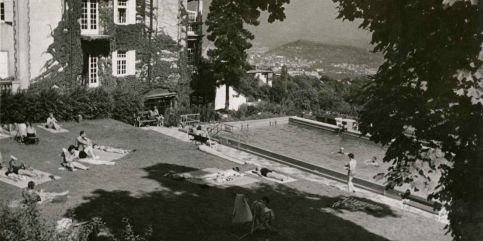Budapest is famous far and wide for its panoramas and its spas and swimming pools. These two were combined by the bathing beach, which opened in the park of the Svábhegy Sanatorium in the summer of 1934. The magnificent, four-storey building of the Svábhegy Sanatorium was completed in 1927 according to the plans of Dezső Jakab and Aladár Soós. In the 12th District, under 10-14 Eötvös Road (12-14 according to the contemporary numbering), the 430-meter-high location of the spa may not sound like much, but the sanatorium in Buda hills which suddenly emerged from the Pest Plain really deserved the “subalpine” mark emphasised when it was opened. As part of the Trianon losses less than a decade earlier, Hungary lost its high-altitude resorts, so the lower-lying but surviving hills became more valuable.
But the sanatorium, which was within reach of the hustle and bustle of the city, was, without any other special reason, a comfortable, attractive destination for the more prominent groups who wanted to relax and heal. The institution defined itself as a “climatic dietary institution” for “holidaymakers, internal medicine and neurotic patients”. Surely, many people also used the sanatorium for rest and recreation, and it became a popular meeting place for the upper social strata. The location of the building provided extremely good conditions. The sanatorium was built in a sunny, wind-protected, and very clean - the operators emphasised this - dry aired place.
The newly opened Svábhegy Sanatorium in 1927 (Photo: Appendices of the 25-year-old Ujság, December 1927)
However, the initial years were overshadowed by the fact that the builder, Chief Physician László Jakab, the head of the sanatorium and the main owner, was in full debt, so the institution was soon transferred to the management of the English-Hungarian Bank. As a result, developments continued. The sanatorium was popular among the upper strata of society, so it is not surprising that after already operating mud baths, electric and oxygen baths, the establishment of an outdoor swimming pool in the park of the sanatorium was planned.
The chief physician of the institution was Dr Béla Györki. Planning began under his leadership, but beach construction was, of course, not only an internal affair of the sanatorium but also related to capital developments, and the construction of an open-air swimming pool on the hill was in line with the ones on Margit Island, Csillaghegy, the Aquincum Roman Baths, and other baths at the time.

Alfréd Hajós created the “sea eye” on Svábhegy in a place with a breathtaking panorama (Excerpt from the news made at the opening of the beach. Magyar Világhíradó 538., June 1934)
Alfréd Hajós was commissioned to design it. Our first Olympic champion, the legendary athlete and architect, had already designed several water facilities at that time, including the National Sports Pool on Margit Island. The beach on Svábhegy was completed in 1934 and opened on 10 June 1934. In his solemn speech, which was also recorded by Filmhíradó, Joseph Francis, Prince of Hungary, the president of the Budapest Spa City Association, spoke about the fact that a high-altitude beach has now been established in Budapest, so the full range of bathing life finally can be found.
The Svábhegy beach after its opening in 1934 (Source: Tér és forma, August 1934)
Not long after, in the heat of July, the papers reported a house full on Svábhegy beach, and in 1935, the chronicler of social life, Színház Élet ('Theater Life') wrote that the governor was a regular guest of the beach bath, and even his daughter, Paulette Horthy wife of Count Károlyi Gyula was “the pride of the beach”.
The world of the Svábhegy beach can also be really perceived from the lines of Színház Élet. “The newest luxury beach in Pest has opened on Svábhegy,” writes the 1-7 July 1934 issue of the paper. "Such a lake on the hilltop was a captivating thought in itself. The foreign guests of Pest consider it a natural formation and the slogan 'lake on Svábhegy' has quickly passed into public consciousness. It is where the aristocracy and the diplomatic corps gather lately. Usually one could only meet such dames in the most upscale sea baths. And for the villa owners in Svábhegy the “lake” is a salvation because they can combine vacation and swimming and not have to give up their comfort to go to the beach.”
Sunbathing over the city, on the beach of Svábhegy (Source: Színház Élet, Issue 30 of 1934)
However, the world of the 1930s was increasingly overshadowed by the impending war. The prominent characters in the description were persecuted after the 1945 collapse. Svábhegy was already called Szabadsághegy ('Liberty Hill') at the time, and the sanatorium was soon nationalised by the new regime and became the scene of the fight against pulmonary tuberculosis (TBC), which had reared its head again. Fortunately, the pool designed by Alfred Hajós remained, but its public use ceased and was available only to doctors and sanatorium staff.
The pulmonary hospital was closed down as early as 1979, and an internal medicine clinic moved into the building, which operated here until 1998. The formerly magnificent building and the park that once hid a thriving beach have been empty since. Recently, news has come to light that a 120-apartment residential park will be built here, leaving the protected main building in place and hopefully taking into account the monumental aspects as much as possible. Unfortunately, the swimming pool is no longer included in the visual plans, so the Svábhegy beach with a magnificent panorama will be just a beautiful memory.
Cover photo: The beach bath of the Svábhegy Sanatorium in the 1930s (Source: FSZEK Budapest Collection)





































Hozzászólások
Log in or register to comment!
Login Registration